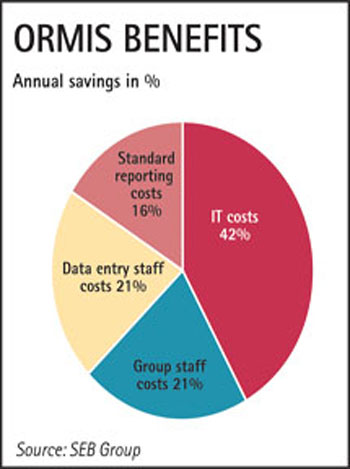SEB Group rolled out an enterprise-wide operational risk management system last year. Bob Giffords takes stock of how it has helped the banking group achieve its customer satisfaction aims.
How does an ambitious, multinational bank seriously aim to be number one for customer satisfaction despite rapid growth and a commitment to a return on equity of more than 20%? For Sweden’s SEB Group, the answer probably lies in its new operational risk management system, ORMIS, which it rolled out last year to all 20,000 group employees.
For Lars Hansén, head of group operational risk, the initial priority was to embed the advanced measurement approaches (AMA) for Basel II operational risk into the group’s decision making. “The risk models have to be easy to understand to be used by all managers, yet sufficiently rigorous to be approved by the regulators,” he says.
User friendly
Audrius Radisauskas, head of operational risk control at Lithuania’s SEB Vilniaus Bankas, emphasises that ease of use is important in countries like Lithuania: “Our managers are very motivated and curious. The system is very structured and logical. They see how their actions impact on their capital allocations.”
Besides the risk model and a corporate loss database, ORMIS includes a common, group-wide system for dealing with customer incidents and complaints, and a workflow system to ensure they are resolved. “We see customer input as an important indicator of the effectiveness of our business processes,” says Mr Hansén.
Anna-Karin Enell, head of group customer relations at SEB, says: “The system helps us demonstrate that the customer comes first by sharing data with everyone who needs to know: product managers, senior management and strategy people, staff or leadership training managers and customer service.”
The workflow features are key, she says. “Managers can’t ignore serious issues. A prompt response encourages staff to use the system and pleases customers.”
SEB’s ambitious goals demand high participation rates. Mr Hansén’s team aims to use ORMIS not only for Basel II and retail customer protection issues, but also for anti-money laundering, the Markets in Financial Instruments Directive (MiFID) and other regulations.
Anders Holmström, compliance officer at SEB Merchant Banking, is looking at how the group can use ORMIS to ensure MiFID compliance. “Besides complaints handling, we can use it, for example, to ensure staff have been updated on changes of policy and have received the appropriate information and training. We shall try to use it as much as possible,” he says.
SEB is also looking to ORMIS to support its Six Sigma quality programme, to track audit issues and embed the culture of continuous improvement, which is a key corporate goal. Because the system holds the entire group management structure, it can drive all the reporting and confirm access permissions as well.
Success story
The core of the system links risk to customer and quality issues, and SEB has had some significant successes there. When the bank found customers writing about their problems on their web logs rather than phoning the bank, it enabled them to input their suggestions on the internet. “The customer complaints or opinions go directly into our database,” says Ms Enell. “And we always answer them.”
In one significant success story, a few complaints from visually handicapped customers revealed difficulties with the bank’s automated teller machines. ORMIS enabled the product manager to quantify the strength of feeling.
“Our product manager decided to introduce a talking cash machine,” says Ms Enell. “Not only did this solve the problem, but the support groups for the disabled picked it up and SEB received a lot of favourable publicity in the media about how we listen to customers.”
For a group-wide system, ORMIS was implemented remarkably quickly. “We chose an external software package from Optial in the UK in April 2005 and rolled out the ORMIS system last summer with multilingual, multi-currency support across all 10 European and Baltic countries in the group,” says Mr Hansén.
Progressively, ORMIS has been replacing dozens of legacy systems for customer complaints, which no longer need to be maintained, giving significant savings. SEB’s motto for this approach is: “One problem, one solution.”
Speedy payback
By taking an enterprise-wide approach, SEB has achieved compliance and improved operational efficiency along with customer satisfaction. The numbers are impressive. “Our payback period for the initial ORMIS investment, including both realised and forecast savings, will be just 13 to 14 months from roll-out in 2006,” says Mr Hansén. “This does not take into account reduced commercial losses or the other intangible benefits.”
Some of these additional benefits include: improved transparency of risks and losses at all levels to inform decision making; improved cost allocation because errors can be debited to profit centres; greater co-ordination of quality and risk management; and more focused audit work prioritised by risk.
Mr Radisauskas adds: “By sharing a common group system, we reduced our costs, but we have also improved our understanding of operational risk by working as part of the group team.”



